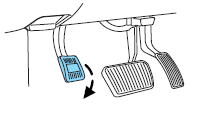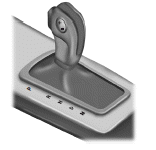Preparing to start your vehicle

WARNING: Extended idling at high engine speeds can produce very high temperatures in the engine and exhaust system, creating the risk of fire or other damage.
WARNING: Do not park, idle, or drive your vehicle in dry grass or other dry ground cover. The emission system heats up the engine compartment and exhaust system, which can start a fire.
WARNING: Do not start your vehicle in a closed garage or in other enclosed areas. Exhaust fumes can be toxic. Always open the garage door before you start the engine. See Guarding against exhaust fumes in this chapter for more instructions.
WARNING: If you smell exhaust fumes inside your vehicle, have your dealer inspect your vehicle immediately. Do not drive if you smell exhaust fumes.
Engine starting is controlled by the powertrain control system.
This system meets all Canadian interference-causing equipment standard requirements regulating the impulse electrical field strength of radio noise.
When starting a fuel-injected engine, avoid pressing the accelerator before or during starting. Only use the accelerator when you have difficulty starting the engine. For more information on starting the vehicle, refer to Starting the engine in this chapter.
Important safety precautions
When the engine starts, the idle RPM runs higher than normal in order to warm the engine. If the engine idle speed does not slow down automatically, have the vehicle checked.
Before starting the vehicle:
1. Make sure all vehicle occupants have buckled their safety belts. For
more information on safety belts and their proper usage, refer to the
Seating and Safety Restraints chapter.
2. Make sure vehicle accessories are off.
Х Make sure the parking brake is set.

Х Make sure the gearshift lever is in P (Park).

See also:
The Inside
I'm not a fan of all-gray interiors, which seem drab to me Ч even more so
than all-black designs Ч but that's what our MKZ had. Getting past my own
preferences, however, let me appreciate a cabin ...
Lincoln custom accessories for your vehicle
A wide selection of Lincoln Custom Accessories are available for your
vehicle through your local Lincoln or Ford of Canada dealer. These
quality accessories have been specifically engineered to fu ...
Collision warning system (if equipped)
The collision warning with brake support, is designed to alert the driver
of certain collision risks with a red warning light located above the
dashboard and an audible warning chime. The brake su ...
